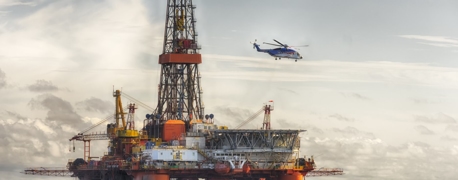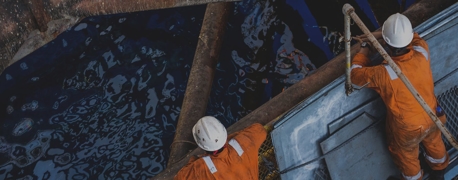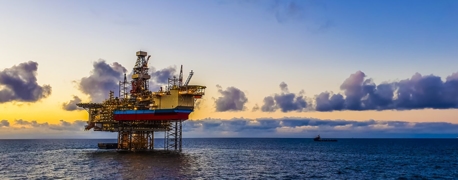Hurricane Warnings: Who Is Responsible for Keeping Oil Rig Workers Safe?

Every spring, the National Oceanic and Atmospheric Administration (NOAA) shares its Atlantic Hurricane Season Outlook, predicting the number of storms to be expected during the official Atlantic hurricane season, which lasts from June 1 through November 30. In 2022, there were 14 named storms (systems with sustained winds of at least 39 mph), with two major hurricanes. In 2023, NOAA predicts 12 to 17.
Forecasters believe five to nine of these storms will be hurricanes (with sustained winds of at least 74 mph) and one to four will be major hurricanes (with sustained winds of at least 111 mph).
The world’s top meteorologists cannot predict with 100% certainty how many hurricanes will happen and where they will strike, particularly not months in advance, but these storms will come. And as each system starts to form, we have the technology to predict its path. We have never been able to make such predictions with as much accuracy as we can today, and yet offshore workers have found themselves in situations time and again where they have not been given enough time to shut in and evacuate the oil platforms where they work. They’ve been battered, bruised, and faced the very real possibility that they would lose their lives at sea. Some have been lost.
What Happens When Offshore Oil Rigs Are Left to Weather Storms?
The Globetrotter II vs. Hurricane Ida
The crew of the Globetrotter II, a Noble-owned and Shell-leased drillship, had a near-death experience as their vessel experienced the full force of Hurricane Ida at the end of August 2021. The vessel was pounded by 80-foot swells and 150-mph winds, with crew members being tossed about and believing they were going to die. The Globetrotter II nearly capsized more than once.
The U.S. Coast Guard was deployed to rescue the 100+ crew members, but the damage had already been done. They had suffered physical and psychological trauma that would continue to haunt them.
The Deepwater Asgard vs. Hurricane Zeta
In October 2020, a similar scenario occurred when Hurricane Zeta struck. A Transocean drilling rig named the Deepwater Asgard was operating in the Gulf of Mexico as a tropical storm approached. The captain of the Asgard started to take measures to evade the incoming storm, but he was ordered to stay put. The tropical storm became a hurricane. The captain ordered the crew to unlatch the Deepwater Asgard and flee from Zeta, but it was too late.
Hurricane Zeta battered the Deepwater Asgard and her crew. The vessel started taking on water at one point, and the crew members suffered physical injuries and emotional trauma during the harrowing ordeal.
When Hurricane Warnings Are Ignored, Crews Pay the Price
The Deepwater Asgard and Globetrotter II are just two instances where hurricane warnings were ignored and crews were left to weather storms. While these crew members (barely) escaped with their lives, the same cannot be said for others. Entire crews have been lost to hurricanes, such as the 33 people aboard the El Faro when she sank in Hurricane Joaquin on October 1, 2015.
Zeta, Joaquin, and Ida were all forecasted. The companies that operated the Asgard, El Faro, and Globetrotter II knew they were coming. And yet, they did not take the appropriate steps to protect their crews.
Shutting In & Evacuating Rigs Before Hurricanes
Offshore rigs must be shut in and evacuated before hurricanes and tropical storms hit. This is not an easy process, and it takes time. Plugging a well, testing the seals, and lifting the multi-million dollar low marine riser package (LMRP) can take days.
In the cases of the Asgard and the Globetrotter II, the crews were not given enough time to cease operations, disconnect, and evade the storms. The Deepwater Asgard was still attached when Hurricane Zeta struck and pushed the rig so far that the riser pipe nearly snapped. The captain ordered an emergency disconnect, which was successfully completed, but the rig’s LMRP suffered significant damage. With the Globetrotter II, the crew was able to successfully detach the LMRP before Hurricane Ida hit, but it was dangling about 500 feet below the vessel as it tried to outrun the storm. The Globetrotter II didn’t stand a chance, as it could only move at about one-third of its normal speed. The LMRP broke off and fell to the seafloor.
Upon investigating the incident involving the Deepwater Asgard, the Bureau of Safety and Environmental Enforcement (BSEE) determined “a key contributing cause” was “the human error decision to stay latched to the well to attempt to ride out the hurricane.”
Hurricanes are not to be trifled with. They are not minor storms you can “ride out” in the middle of the ocean. They are catastrophic events that will damage and sink any vessels in their paths. Offshore companies need to recognize this and start putting the safety of their crews ahead of their desires to get a few more days of production out of a platform by delaying evacuations or evasive measures.
They must follow proper hurricane preparedness procedures.
Offshore Companies Are Responsible for Hurricane Preparedness
The responsibility for hurricane preparedness lies with the companies that own and run offshore drilling operations. In a nutshell, they must develop appropriate hurricane response plans, use the tools and information at their disposal to stay appraised of current weather conditions, and shut in and evacuate platforms in a timely manner. With current weather prediction capabilities – not to mention the accessibility of tropical storm and hurricane information – there is truly no excuse for not evacuating an offshore platform in time.
After the incidents involving the Globetrotter II and Deepwater Asgard, offshore companies are facing new storm avoidance rules.
The BSEE, which was established after the 2010 Deepwater Horizon disaster and is tasked with inspecting and regulating offshore drilling operations, is implementing new rules for the 2022 Atlantic hurricane season. Offshore companies must now report the “T-Time” to the BSEE regarding their offshore platforms. This is the amount of time it takes to evacuate the rig before a storm. Those companies operating in the Gulf of Mexico must also provide the BSEE with regular updates regarding shut ins and evacuations as they progress.
Who Is Responsible for Notifying Rigs & Their Crews of Inclement Weather?
We’ve talked about hurricane preparedness and T-Times, but what about hurricane warnings themselves? Who is responsible for notifying oil rigs of incoming storms?
Again, the responsibility lies with the owners and operators of offshore platforms to ensure crews are properly informed of weather conditions. This involves a combination of closely monitoring weather reports and using onboard equipment, such as weather radars, to keep apprised of current conditions. From there, companies need to make the right decisions about shutting in and evacuating offshore operations. They must give crews enough time to safely shut in wells and leave at-risk areas.
Hurricanes will come. It’s up to offshore companies to take the right measures to protect their crews by evading heavy weather and evacuating platforms before storms strike.


